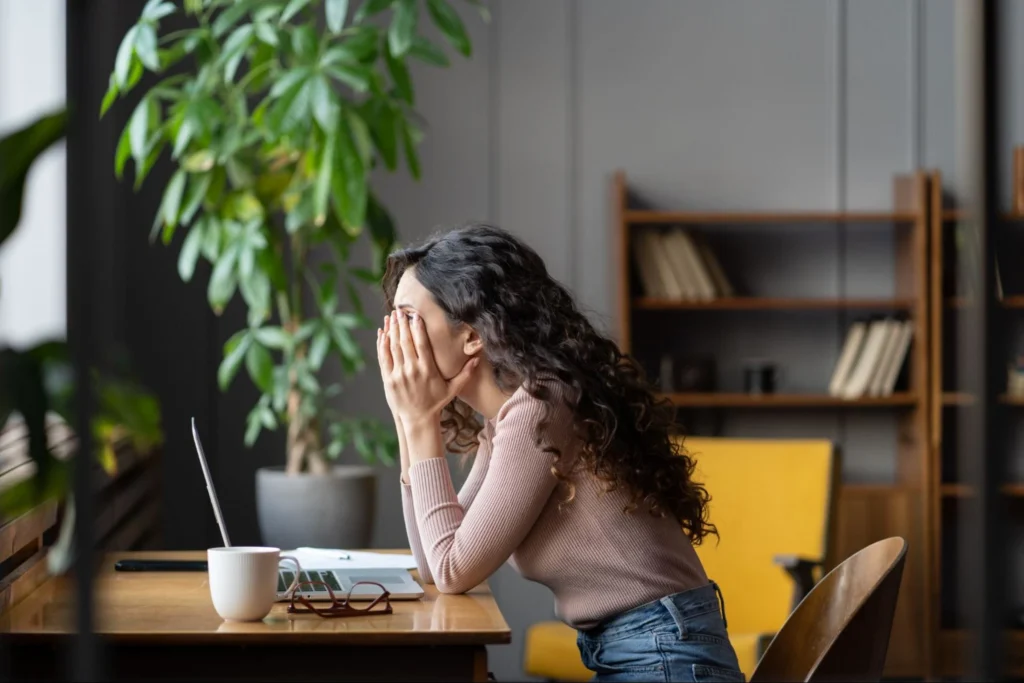A lot of the time in my work with clients, anxiety is a new topic for them. Everyone at some point has heard the term, or has known people personally who experience it, but anxiety can go unrecognized in themselves for a long time.
Many clients will start the therapy process wanting to work on things such as poor work boundaries, ineffective communication skills, people pleasing, or feeling stressed all the time.
During our work together, clients may start realizing that these issues they’re experiencing are actually related to anxiety!

Recognizing what anxiety actually looks like and how it shows up in your day-to-day life can be very helpful in taking steps to address it and reduce its impact in your life. Here are some frequently-asked-questions to help you identify what anxiety might look like for you!
1. What’s the difference between Anxiety and Stress?
I often hear these words used interchangeably, but I find it really helpful to look at these two very distinctly, because they play very different roles in our lives!
Anxiety is a behavior that manifests with many different symptoms. Anxiety can often be characterized as behavior that operates around a person’s fears or worries about the future. For example, a person who experiences anxiety may feel stressed and anxious about an upcoming presentation, and experience symptoms of hyperventilating and panic whenever they think about the topic.
Stress, on the other hand, is the body’s physiological response to these threatening events. It can be experienced both physically and mentally, sometimes showing up as fatigue, aches and pains, nausea, headaches, irritability, memory issues, and feeling overwhelmed. Stress can also often be a symptom of prolonged anxiety, though you can feel stressed without also experiencing anxiety. 2.
2. What are common Anxiety symptoms or behaviors?
Common anxiety symptoms include feeling a sense of impending doom/danger, breathing rapidly, feeling weak or trembling, breathlessness, excessive sweating, and feelings of nervousness or panic. I see these symptoms most commonly when my clients are experiencing anxiety in the moment (like during a panic or anxiety attack)– but anxiety behaviors can be a little harder to spot.
I often see anxiety behaviors show up like Perfectionism, People-Pleasing, and Hopelessness. These behaviors allow my clients to mitigate or avoid conflict or negative experiences, which helps protect them from feeling disappointed, rejected, like a failure, or other painful feelings. It can also look like over-analyzing, fear-based decision-making, procrastination, or irrational or distorted thinking.
3. Why do I experience Anxiety? Does it go away?
Anxiety can be helpfully characterized as a behavior that plays a role in our lives for a lot of different reasons. With a lot of my clients, anxiety’s role developed to protect them from threatening situations. For example, anxiety allows someone to analyze many different scenarios that may play out in making decisions, and helps them to understand the many different areas in life a decision may impact. Or, at work, anxiety allows a person to notice and finish very detail-oriented tasks that might be looked over or missed. Anxiety in this role allows my clients to avoid or mitigate conflicts at work or in their personal lives that may be scary or threatening for them to experience, even if the cons of anxiety sometimes outweigh the pros.
I often hear clients say they want to “fix” the way they feel, or that they want to “get rid of” the anxiety. But I would challenge my clients to analyze that sentiment a little deeper– this is a function of you, designed to keep you safe. It is a part of you. What would happen if we were to accept it? What would life look like if we were to integrate anxiety into our lives? What if it didn’t have to go away, but instead could change its function to better serve you?
4. Why do I feel anxious when there’s no reason?
Understanding anxiety’s role in our lives is essential to understanding how and when we experience anxiety. Anxiety is often triggered by emotions, environmental stimuli, or others’ words or actions towards us. If you’re often experiencing anxiety “coming from nowhere”, there’s a good chance you haven’t identified your triggers yet.
Identifying triggers is a really important step in helping you understand why you are reacting in the way that you are. The next time you experience anxious feelings and are not sure where they’re coming from, practice being curious about the anxiety– “What about the situation is making me feel this way?” , “When have I felt like this before?” Questions from a place of curiosity and exploration can lead us to powerful insights.
5. How exactly does therapy help with Anxiety?
Therapy is a great tool to help you understand why this behavior developed, how it may be impacting you, when and how you are triggered, and to learn coping strategies to help manage symptoms in your life. I use CBT and talk therapy to help my clients explore what anxiety means to them individually, and identify which behaviors are hindering vs. helping.
In the beginning of therapy, working with anxiety can feel like learning how to flex a new muscle. At first, it feels awkward, uncomfortable, and takes conscious effort to identify and work through anxiety. But with practice, time, and patience, that skill slowly becomes easier and more instinctive. It’s possible to live a life that you want with anxiety!
Feeling ready to start the therapy process? Click here to get in touch with one of our Fava Counseling therapists today!



